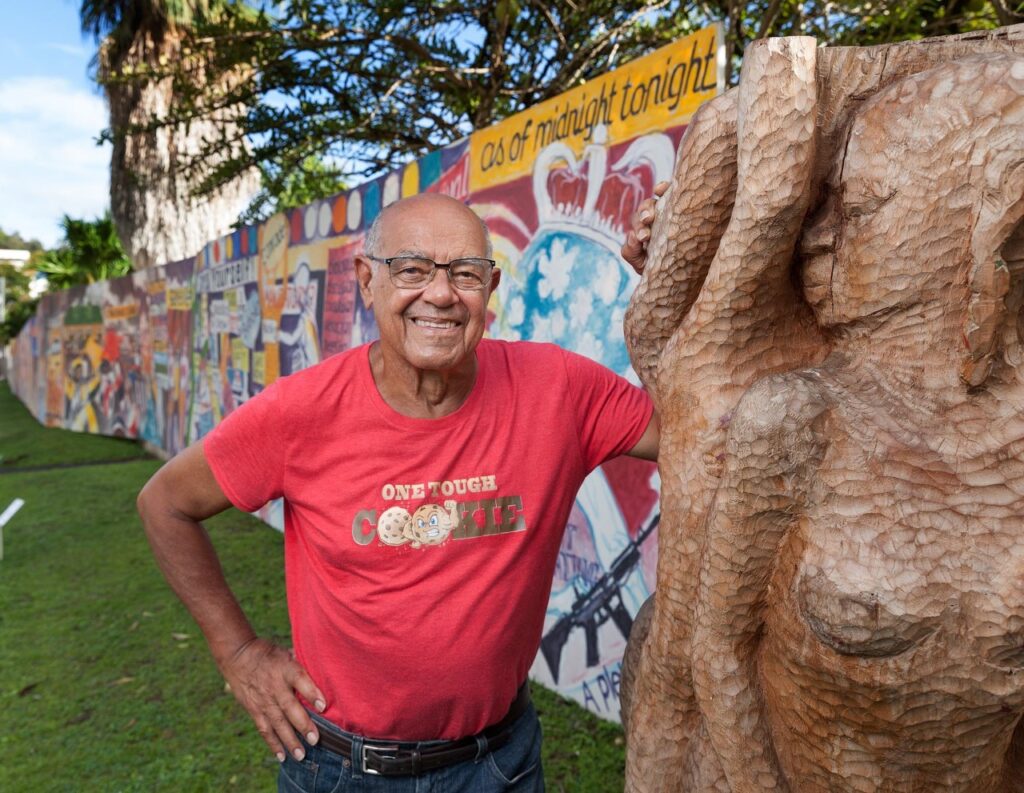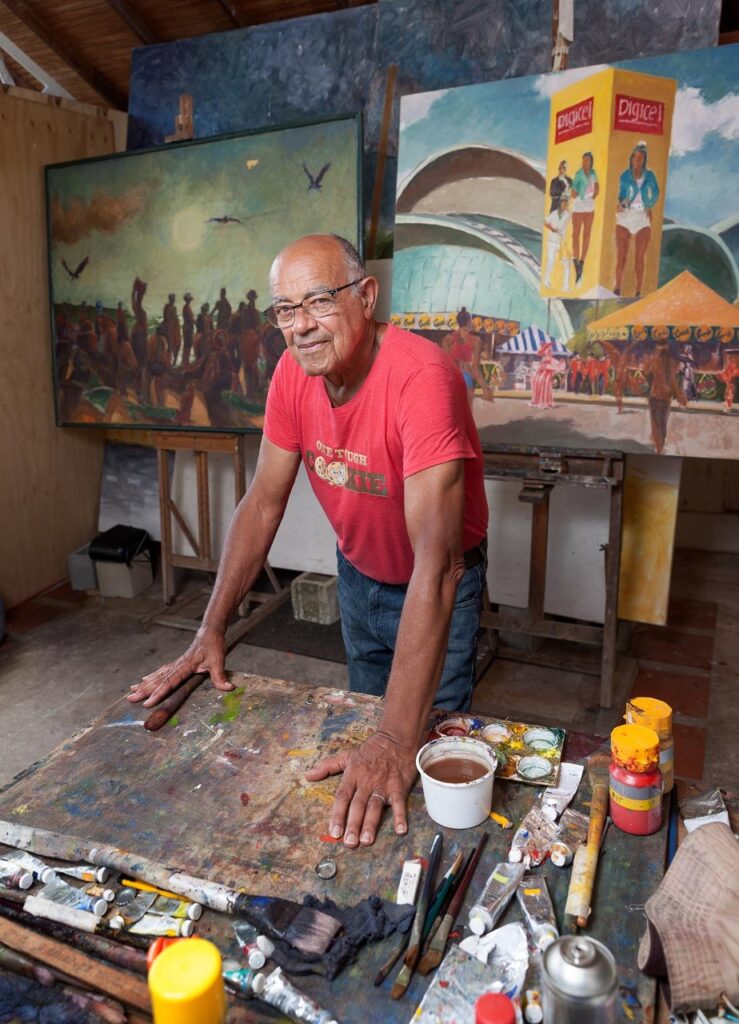The road make to show art on Carnival Day

AS TOLD TO BC PIRES
My name is Jackie Hinkson and today, March 7, is the last day to see my street exhibition of art at Fisher Avenue, St Ann’s, Port of Spain before it is taken down this afternoon.
A practising artist in TT for some 60 years in various mediums, I’m displaying my large, mural-sized works in the street.
I did it last year because of covid and no Carnival. It made sense because a lot of the imagery in the work is Carnival-related or -inspired.
My first name is Donald, but probably because she had no playpen, my mother used to put me in a big cardboard box as she did her housework.
Someone said I was a real little Jack-in-the-box. And so I became Jackie.
All the Hinkson children had nicknames at home.
One uncle took a look at my very flat feet and said, “Boat Foot!”
Today, you couldn’t give people the nicknames Trinidad did when I was a boy.
In a curious way, that level of fatigue in nicknames hardened us. If anybody drop a fatigue on me now, it just flows off of me.
I’m from Cobo Town, an area prominent in early Central Port of Spain, between Duke Street and London Street, Richmond Street and Wrightson Road.
My mother tells me about walking down Charles Street as a girl to what is now Wrightson Road and dipping her foot in the sea!
Cobo Town had all those features of 1950s Trinidad: your barrackyard; your Chinese shop; your residential houses, some humble.
Cobo Town was not as big as Woodbrook or Belmont but it was vibrant.
Red Army came from Cobo Town: how much more vibrant could you get than that?
Early schooling was Richmond Street Boys’ RC. Not one of the prestigious primary schools like Belmont or Tranquil, but it was strong. Boys came from Cobo Town, Newtown, Woodbrook, “Behind the Bridge,” Upper Duke Street.
One of my best friends, Mervyn Wells, lived in a barrackyard in Richmond Street with his mother – no father around. Mervyn became the sports editor of the Express.
(Sweden-based renowned pannist Rudy) Two Left (Smith) lived in a barrackyard on Charles Street. He was always in our yard.
That’s the kind of community we had.
On a Friday morning at Queen’s Royal College, for one period, several people, an Anglican, a Catholic, a this and a that, came in for religious instruction.
For we boys, it was a free period. You glad for that! Who listening to this man going on about all this biblical thing?
I have this vague belief of some kind of “force,” a mystery I don’t understand but have to respect.
But I would not declare myself an agnostic or atheist. It’s not important, you know?
I’m 80 this year. Eighty! At one level, I’m – well, not frightened, but aware – I can’t fool around with my time. I can’t
waste time. So my focus is, “Get to work! Get to work! Get to work!”
I prefer to work standing up. I don’t like to sit down. You can’t sit and paint this stuff anyway.

To stand up for five, six, seven, eight hours is a lot of effort.
Anybody working on this scale has to have a warehouse, to stand back and see the whole thing and make decisions.
Working in my garage, I don’t have that luxury. Over months, I can only work on two panels at a time. I have to shift a panel, bring in another one, have a picture of the panel I removed on an iPad next to me, make the panels visually harmonise somehow.
It’s not the ideal way to work and it’s always a surprise to see the final work. But it’s turned out to be a happy surprise.
The latest murals, focusing a bit more on social observation, were done over the last two, three years. The first long one, 110 feet, was done at least ten years ago.
People tell me they see protest in these murals, but I don’t see it or feel it.
Maybe I don’t even know what I’m doing, it’s so intuitive. Maybe I’m doing it unconsciously.
Queen Isabella is something like a burrokeet, because, throughout the entire works, I want to keep the Carnival imagery. Almost as though I’m saying life in Trinidad is like a Carnival band.
You can interpret that as you wish. Bacchanal? Or serious expression of something?
With allusions to the Friendly Society, am I saying this was a friendly society back then?
I like playing with these subtleties. Let the viewer bring their baggage to the thing.
Columbus’ presence in our lives and symbols became a prominent question.
There’s a Tobago group called a speech band who wear ships as headpieces. I say, “Nice! They will wear Columbus’ ships as they make their speech and dance!”
I’m trying to allude to things all the time. And tie them in. However subtly.
As fast as events were happening, I was interpreting them metaphorically using Carnival imagery. Sometimes with a little humour thrown in. Corona virus is there in the sky, hovering. (Health Minister) Deyalsingh says 100,000 jab coming, so I have plenty jab coming – of course jab is (traditional Carnival mas) devil, and jab is also inoculation.
The neighbours have been really good, really tolerant of people driving in, walking around their street to look at the work.
The best part has been the communication with a wider public that would never enter an art gallery or museum.
The downside is that the weather affects the work.
And, of course, what is going to happen to the works from now on. But that is a constant worry.
I am not consciously trying to make people think along a particular line.
I have always said good art – and I am not saying mine is good art – is multilayered. You can’t appreciate it at one level.
A lot of people tend to look at the surface subject-matter, at what is represented. Sometimes one character can suggest more than one emotion and the visual composition brings another dimension.
A Trini is so many things, but I suppose I see a Trini mainly as a contradiction.
I see people capable of being so expressive, so vibrant and creative – but, at the same time, being so shallow and stupid and silly.
Because what I experienced in my childhood and youth is so powerful and so permanent, that is what Trinidad and Tobago means to me: I can’t separate myself from Trinidad and Tobago.
I can’t leave here. I can’t adopt another culture, no matter how attractive.
Trinidad and Tobago is embedded in my thinking and my vision of everything I paint or sculpt, my experiences as a Trinidadian.
Read the full version of this feature on Friday evening at www.BCPires.com


Comments
"The road make to show art on Carnival Day"